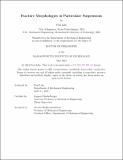Fracture Morphologies in Particulate Suspensions
Author(s)
Lilin, Paul
DownloadThesis PDF (79.03Mb)
Advisor
Bischofberger, Irmgard
Terms of use
Metadata
Show full item recordAbstract
Films of a colloidal suspension solidify and crack during drying and discontinuously shearthickening suspensions shear-jam and fracture under applied stress. In both systems, the morphology and dynamics of fracture reveal the internal stresses in the material: craquelures in old paintings reveal details of the painting technique used; crack patterns of drying drops of blood contain forensic evidence; and growing fractures in dense suspensions constitute a structural signature of shear jamming. In this thesis, we develop an in-depth physical understanding of the fracture dynamics and morphology in two particulate suspensions: Drying sessile drops of colloidal suspensions and discontinuously shear-thickening suspensions subject to air injection. Wefirst highlight distinct modes of stress release in drying drops of colloidal suspensions. As water evaporates from a freshly deposited drop, a thin close-packed particle deposit forms at the edge of the drop and grows inward. Water evaporation from this particle deposit combined with adhesion of the deposit to the substrate causes tensile stresses leading to the formation of regular radial cracks. Depending on whether the deposit then remains attached to the substrate or delaminates, the remaining stresses in the deposit get released in different ways: If the deposit remains attached, stresses are released by the formation of orthoradial cracks that bridge the radial cracks, creating a complex crack pattern. Conversely, no additional cracks form if the deposit delaminates. Instead, the deposit curves and deforms out of plane to relieve drying stresses, creating shapes that resemble blooming flowers. We show how the combination of poroelasticity with fracture mechanics and non-Euclidian plate mechanics captures both the complex crack pattern formation and the out-of-plane deformation as distinct responses to a similar drying stress. We then probe the fracture and relaxation characteristics of a discontinuously shearthickening suspension placed in an open three-dimensional container and subject to air injection. X-ray images reveal the growth of an air cavity with shapes ranging from smooth bubbles that rise upwards under the action of buoyancy to sharp cracks that remain attached to the injection nozzle. We show that the shape and the relaxation dynamics of the air cavity are linked to the rheology of the suspension: Sharp cracks relax into bubbles when the shear rate applied to the suspension by the bubble growth decreases below the critical shear rate denoting the onset of discontinuous shear thickening. Our findings suggest ways to tune crack patterns and to infer stresses and material properties from fracture dynamics in both drying suspensions and shear-jamming suspensions.
Date issued
2024-05Department
Massachusetts Institute of Technology. Department of Mechanical EngineeringPublisher
Massachusetts Institute of Technology